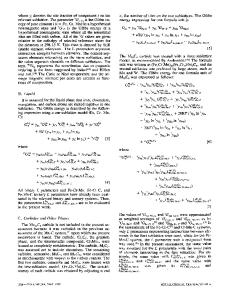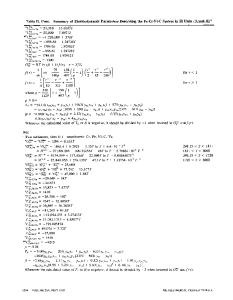A thermodynamic evaluation of the Cr-Fe-N system
- PDF / 1,020,750 Bytes
- 12 Pages / 594 x 774 pts Page_size
- 75 Downloads / 321 Views
I.
INTRODUCTION
THERE have
been several investigations of the phase relations in the Cr-Fe-N system. Raghavan [1] reviewed the experimental data and proposed a reaction scheme, a liquidus surface, and some isothermal sections. Hertzman and J a r l [21 studied the available experimental data and supplemented tiffs information with some of their own measurements. They analyzed the existing data with the use of thermodynamic models describing the Gibbs energy of each phase. The parameters involved in the models were determined by searching the best fit to experimental data using a computer program. The present work is a reassessment of the Cr-Fe-N system using the same method as Hertzman and Jarl but also including the liquid phase that was not studied previously. Recently, new assessments of the binary systems Cr-Fe, Cr-N, and Fe-N have been presented, t3,4] Therefore, a complete reevaluation was necessary to make the description of solid phases in the ternary Cr-Fe-N system consistent with the binaries. The models for the nitrides have been changed t4] due to new experimental data, and the set of model parameters determined from ternary data is now different. When the reevaluation was performed, new experimental data were taken into account. The most important ones come from a recent investigation by Feichtinger et al. t~] on the solubility of N in solid and liquid Cr-Fe alloys under and above 1 atm N2 pressure. A new selection of experimental data was made, and the data were reanalyzed with the thermodynamic models. With improved computer programming, it is possible to take all experimental data into account simultaneously, whereas Hertzman and Jarl t2] analyzed each temperature separately. An attempt was also made to improve the agreement with experimental data in certain parts of the diagram. Any phase equilibrium or part of a phase diagram can be recalculated from the Gibbs energy func-
KARIN FRISK, Doctor, is with the Division of Physical Metallurgy, Royal Institute of Technology, S-100 44 Stockholm, Sweden. Manuscript submitted September 29, 1989. METALLURGICAL TRANSACTIONS A
tions. The calculations are compared with available experimental data and with the previous assessment. II.
THERMODYNAMIC MODELS
A. The Nitrides and the Bcc and Fcc Phases
The binary Cr-Fe system was previously analyzed by Andersson and Sundman, ~3]and their assessment was used in the present work. In this system, ferrite, a body-centered cubic (bcc) solid solution (a), exists as a continuous phase (Figure 1). Austenite, a face-centered cubic (fcc) solid solution (T), is restricted to the Fe-rich comer. The bcc and fcc phases are described by a two-sublattice model, where it is assumed that Cr and Fe substitute for each other on the first sublattice and N and vacant interstitial sites (denoted Va) on the second. Body-centered cubic and face-centered cubic are thus represented by the model (Cr, Fe)l(N, Va)o with c = 3 for bcc and c = 1 for fcc. The o- phase appears below 1100 K in the Cr-Fe system. Sincr the solubility of N in tr i
Data Loading...











